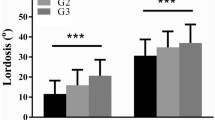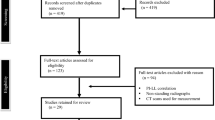Abstract
Study Design
Retrospective review; literature comparison.
Objectives
To review the literature on the relationship between lumbar lordosis (LL) and pelvic incidence (PI) and evaluate this relationship in asymptomatic adolescents while testing the validity of previously reported adult correlation models between LL and PI in an adolescent population.
Summary of Background Data
Accurate understanding of the normal spinopelvic relationship is critical when considering surgical fusion of the lumbar spine. Many studies have reported relationships between pelvic measurements and LL in adult populations, but data in pediatric populations is lacking.
Methods
A literature search was performed to identify previously reported relationships between pelvic parameters and LL in adults and pediatric patients. A cohort of 125 asymptomatic adolescent patients evaluated at our institution was evenly split into two cohorts for model development and validation. Linear regression between LL and PI was performed. The resultant regression model was tested in the validation cohort along with previously reported formulae with LL as a function of PI. Mean absolute error (MAE) was calculated and compared between prior models and the newly developed adolescent model using analysis of variance and post-hoc testing.
Results
In our adolescent cohort (mean age: 13 ± 2), there was a strong correlation between PI and LL (r = 0.53). Regression analysis in the development cohort produced the following predictive model: LL = 0.66(PI) + 24.2. Testing in the validation cohort revealed a good correlation between predicted and actual LL (r = 0.51) and an MAE of 8.3. All but three previously reported models functioned with similar accuracy in the adolescent population, with only two methods having an MAE over 10.
Conclusions
The majority of previously published formulae for predicting LL as a function of PI developed in adults can be extrapolated to adolescent populations. These relationships are important in understanding how to surgically restore the sagittal alignment in adolescents with spinal deformity.
Level of Evidence
Level IV.
Similar content being viewed by others
References
Glassman SD, Bridwell K, Dimar JR, et al. The impact of positive sagittal balance in adult spinal deformity. Spine (Phila Pa 1976) 2005;30:2024–9.
Rogala EJ, Drummond DS, Gurr J. Scoliosis: incidence and natural history. A prospective epidemiological study. J Bone Joint Surg Am 1978;60:173–6.
Schwab F, Lafage V, Boyce R, et al. Gravity line analysis in adult volunteers: age-related correlation with spinal parameters, pelvic parameters, and foot position. Spine (Phila Pa 1976) 2006;31:E959–67.
Blondel B, Schwab F, Ungar B, et al. Impact of magnitude and percentage of global sagittal plane correction on health-related quality of life at 2-years follow-up. Neurosurgery 2012;71:341–8; discussion 348.
Lafage V, Schwab F, Patel A, et al. Pelvic tilt and truncal inclination: two key radiographic parameters in the setting of adults with spinal deformity. Spine (Phila Pa 1976) 2009;34:E599–606.
Lee JH, Kim KT, Lee SH, et al. Overcorrection of lumbar lordosis for adult spinal deformity with sagittal imbalance: comparison of radiographic outcomes between overcorrection and undercorrection. Eur Spine J 2016;25:2668–75.
Aurouer N, Obeid I, Gille O, et al. Computerized preoperative planning for correction of sagittal deformity of the spine. Surg Radiol Anat 2009;31:781–92.
Berjano P, Langella F, Ismael MF, et al. Successful correction of sagittal imbalance can be calculated on the basis of pelvic incidence and age. Eur Spine J 2014;23(suppl 6):587–96.
Boissiere L, Bourghli A, Vital JM, et al. The lumbar lordosis index: a new ratio to detect spinal malalignment with a therapeutic impact for sagittal balance correction decisions in adult scoliosis surgery. Eur Spine J 2013;22:1339–45.
Boulay C, Tardieu C, Hecquet J, et al. Sagittal alignment of spine and pelvis regulated by pelvic incidence: standard values and prediction of lordosis. Eur Spine J 2006;15:415–22.
Kim YJ, Bridwell KH, Lenke LG, et al. An analysis of sagittal spinal alignment following long adult lumbar instrumentation and fusion to L5 or S1: can we predict ideal lumbar lordosis? Spine (Phila Pa 1976) 2006;31:2343–52.
Lafage V, Schwab F, Vira S, et al. Spino-pelvic parameters after surgery can be predicted: a preliminary formula and validation of standing alignment. Spine (Phila Pa 1976) 2011;36:1037–45.
Le Huec JC, Hasegawa K. Normative values for the spine shape parameters using 3D standing analysis from a database of 268 asymptomatic Caucasian and Japanese subjects. Eur Spine J 2016;25: 3630–7.
Lee CS, Chung SS, Park SJ, et al. Simple prediction method of lumbar lordosis for planning of lumbar corrective surgery: radiological analysis in a Korean population. Eur Spine J 2014;23:192–7.
Legaye J, Duval-Beaupere G. Sagittal plane alignment of the spine and gravity: a radiological and clinical evaluation. Acta Orthop Belg 2005;71:213–20.
Legaye J, Duval-Beaupere G, Hecquet J, Marty C. Pelvic incidence: a fundamental pelvic parameter for three-dimensional regulation of spinal sagittal curves. Eur Spine J 1998;7:99–103.
Mac-Thiong JM, Labelle H, Berthonnaud E, et al. Sagittal spinopelvic balance in normal children and adolescents. Eur Spine J 2007;16:227–34.
Neal CJ, McClendon J, Halpin R, et al. Predicting ideal spinopelvic balance in adult spinal deformity. J Neurosurg Spine 2011;15:82–91.
Rose PS, Bridwell KH, Lenke LG, et al. Role of pelvic incidence, thoracic kyphosis, and patient factors on sagittal plane correction following pedicle subtraction osteotomy. Spine (Phila Pa 1976) 2009;34:785–91.
Schwab F, Lafage V, Patel A, Farcy JP. Sagittal plane considerations and the pelvis in the adult patient. Spine (Phila Pa 1976) 2009;34:1828–33.
Schwab F, Patel A, Ungar B, et al. Adult spinal deformity—postoperative standing imbalance: how much can you tolerate? An overview of key parameters in assessing alignment and planning corrective surgery. Spine (Phila Pa 1976) 2010;35:2224–31.
Tanguay F, Mac-Thiong JM, de Guise JA, Labelle H. Relation between the sagittal pelvic and lumbar spine geometries following surgical correction of adolescent idiopathic scoliosis. Eur Spine J 2007;16:531–6.
Vialle R, Levassor N, Rillardon L, et al. Radiographic analysis of the sagittal alignment and balance of the spine in asymptomatic subjects. J Bone Joint Surg Am 2005;87:260–7.
Xu L, Qin X, Zhang W, et al. Estimation of the ideal lumbar lordosis to be restored from spinal fusion surgery: a predictive formula for Chinese population. Spine (Phila Pa 1976) 2015;40:1001–5.
Yang C, Yang M, Wei X, et al. Lumbar lordosis minus thoracic kyphosis: a novel regional predictor for sagittal balance in elderly populations. Spine (Phila Pa 1976) 2016;41:399–403.
Iyer S, Lenke LG, Nemani VM, et al. Variations in sagittal alignment parameters based on age: a prospective study of asymptomatic volunteers using full-body radiographs. Spine (PhilaPa 1976) 2016;41:1826–36.
Burton D, Hanstein R, Schulz JF, Gomez JA. How are we affecting spinopelvic parameters in patients with idiopathic scoliosis. J Pediatr Orthop 2017;37:156–7.
Sullivan TB, Reighard FG, Osborn EJ, et al. Thoracic idiopathic scoliosis severity is highly correlated with 3D measures of thoracic kyphosis. J Bone Joint Surg Am 2017;99:e54.
Mac-Thiong JM, Berthonnaud E, Dimar 2nd JR, et al. Sagittal alignment of the spine and pelvis during growth. Spine (Phila Pa 1976) 2004;29:1642–7.
Mangione P, Gomez D, Senegas J. Study of the course of the incidence angle during growth. Eur Spine J 1997;6:163–7.
Duval-Beaupere G, Schmidt C, Cosson P. A Barycentremetric study of the sagittal shape of spine and pelvis: the conditions required for an economic standing position. Ann Biomed Eng 1992;20:451–62.
Vaz G, Roussouly P, Berthonnaud E, Dimnet J. Sagittal morphology and equilibrium of pelvis and spine. Eur Spine J 2002; 11:80—7.
Labelle H, Roussouly P, Berthonnaud E, et al. Spondylolisthesis, pelvic incidence, and spinopelvic balance: a correlation study. Spine (Phila Pa 1976) 2004;29:2049–54.
Berthonnaud E, Dimnet J, Roussouly P, Labelle H. Analysis of the sagittal balance of the spine and pelvis using shape and orientation parameters. J Spinal Disord Tech 2005;18:40–7.
Roussouly P, Gollogly S, Berthonnaud E, Dimnet J. Classification of the normal variation in the sagittal alignment of the human lumbar spine and pelvis in the standing position. Spine (Phila Pa 1976) 2005;30:346–53.
Barrey C, Jund J, Noseda O, Roussouly P. Sagittal balance of the pelvis-spine complex and lumbar degenerative diseases. A comparative study about 85 cases. Eur Spine J 2007;16:1459–67.
Author information
Authors and Affiliations
Corresponding author
Additional information
This study was conducted at Rady Children’s Hospital, San Diego, CA.
Author disclosures: TBS (none), NM (none), FGR (none), PON (grants and other from the Setting Scoliosis Straight Foundation, other from Rady Children’s Specialists, grants and personal fees from DePuy Synthes Spine, personal fees from Law firm of Carroll, Kelly, Trotter, Franzen & McKenna, personal fees from Law firm of Smith, Haughey, Rice & Roegge, grants from NIH, grants from OREF, grants and other from SRS, grants from EOS imaging, personal fees from Thieme Publishing, other from NuVasive, personal fees from Ethicon Endosurgery, other from Electrocore, personal fees from Cubist, other from International Orthopedic Think Tank, other from Orthopediatrics Institutional Support, personal fees from K2M, outside of the submitted work; in addition, a patent “Anchoring systems and methods for correcting spinal deformities” (8540754) with royalties paid to DePuy Synthes Spine, a patent “Low profile spinal tethering systems” (8123749) issued to DePuy Spine, Inc., a patent “Screw placement guide” (7981117) issued to DePuy Spine, Inc., and a patent “Compressor for use in minimally invasive surgery” (7189244) issued to DePuy Spine, Inc.).
Research support is gratefully acknowledged from the Rady Children’s Foundation Assaraf Family Research Fund and a Surgical Department grant from Rady Children’s Specialists of San Diego.
Rights and permissions
About this article
Cite this article
Sullivan, T.B., Marino, N., Reighard, F.G. et al. Relationship Between Lumbar Lordosis and Pelvic Incidence in the Adolescent Patient: Normal Cohort Analysis and Literature Comparison. Spine Deform 6, 529–536 (2018). https://doi.org/10.1016/j.jspd.2018.02.002
Received:
Revised:
Accepted:
Published:
Issue Date:
DOI: https://doi.org/10.1016/j.jspd.2018.02.002




